
Papal Coinage
.pdf
PAPAL COINS
Alexander VI., 1492-1503.
Grosso. Ancona mint.
Obv.: Coat of arms surmounted by crossed keys and papal tiara, in quadrilobe. .ALEXANDER. .VI.PONT..MAX.
Rev.: Nimbate St. Paul with sword and book and nimbate St. Peter with key and book stand frontal, both facing slightly to center. Mintmark between them at bottom. S PAVLVS S PETRVS /MARCI
Rare. VF+
Estimate: 200 EUR. Price realized: 750 EUR (approx. 1,150 U.S. Dollars as of the auction date)
PAPAL COINS
Alexander VI., 1492-1503.
Grosso. Ancona mint.
PAPAL COINS
Alexander VI., 1492-1503.
Grosso. Rome mint. 2.71 g.
Obv.: ALEXANDER VI PONT MAX, papal arms; above crossed keys and tiara.
Rev.: .S.PETRVS -S.PAVLVS, Saints Peter ( holding naked sword ) and Paul standing ( holding keys to a better world ), in exergue ROMA.
Reference: Berman 532. About extremely fine, some striking weakness and small flan split on edge.Above average condition for this Pope.
Estimate: £ 165.00.
PAPAL COINS
Alexander VI., 1492-1503.
Grosso. Rome mint. 3,29 g.
Obv.: Coat of arms surmounted by crossed keys and papal tiara, in quadrilobe. .ALEXANDER. .VI.PONT..MAX.
Rev.: Nimbate St. Paul with sword and book and nimbate St. Peter with key and book stand frontal, both facing slightly to center. Mintmark between them at bottom. S PAVLVS S PETRVS /MARCI
Reference: Berman-538, Choice VF/XF.
Estimate: 200-250 USD. Price realized: 200 USD.
Obv.: Coat of arms surmounted by crossed keys and papal tiara, in quadrilobe. .ALEXANDER. .VI.PONT..MAX.
Rev.: Nimbate St. Paul with sword and book and nimbate St. Peter with key and book stand frontal, both facing slightly to center. Rosette between them at bottom. S PAVLVS S PETRVS /ROMA
Reference: Berman 532; CNI 48; Muntoni 16. VF.
Estimation DM 250. Price realized: 330 DEM (approx. 150 U.S. Dollars as of the auction date)

PAPAL COINS |
PAPAL COINS |
Alexander VI., 1492-1503. |
Alexander VI., 1492-1503. |
Grosso. Rome mint. |
Grosso. Rome mint. 2,85 g. |
Obv.: Coat of arms surmounted by crossed keys and papal tiara, in quadrilobe. .ALEXANDER. .VI.PONT..MAX.
Rev.: Nimbate St. Paul with sword and book and nimbate St. Peter with key and book stand frontal, both facing slightly to center. Rosette between them at bottom. S PAVLVS S PETRVS /ROMA
Reference: Muntoni 16. Attractive example, VF+
Estimate: 100 EUR. Price realized: 320 EUR (approx. 423 U.S. Dollars as of the auction date)
PAPAL COINS
Alexander VI., 1492-1503.
Grosso. Ancona mint.
Obv.: Coat of arms surmounted by crossed keys and papal tiara, in quadrilobe. .ALEXANDER. .VI.PONT..MAX.
Rev.: Nimbate St. Paul with sword and book and nimbate St. Peter with key and book stand frontal, both facing slightly to center. Rosette between them at bottom. S PAVLVS S PETRVS /ROMA
Reference:Munt., 16; Berman, 532. VF
Estimate: EUR 150. Price realized: 180 EUR (approx. 227 U.S. Dollars as of the auction date)
PAPAL COINS
Alexander VI., 1492-1503.
Grosso. Ancona mint. 2.65 g.
Obv.: Coat of arms surmounted by crossed keys and papal tiara, in quadrilobe. .ALEXANDER. .VI.PONT..MAX.
Rev.: Nimbate St. Paul with sword and book and nimbate St. Peter with key and book stand frontal, both facing slightly to center. Mintmark between them at bottom. S PAVLVS S PETRVS /MARCI
Reference: Munt: 96, 23. XF.
Estimate: EUR 250. Price realized: 320 EUR (approx. 406 U.S. Dollars as of the auction date)
Obv.: Coat of arms surmounted by crossed keys and papal tiara, in quadrilobe. .ALEXANDER. .VI.PONT..MAX.
Rev.: Nimbate St. Paul with sword and book and nimbate St. Peter with key and book stand frontal, both facing slightly to center. Mintmark between them at bottom. S PAVLVS S PETRVS /MARCI
Reference: Muntoni I pg. 96, 23; Berman 538. Toned VF.
Estimate $150. Price realized: 272 USD.
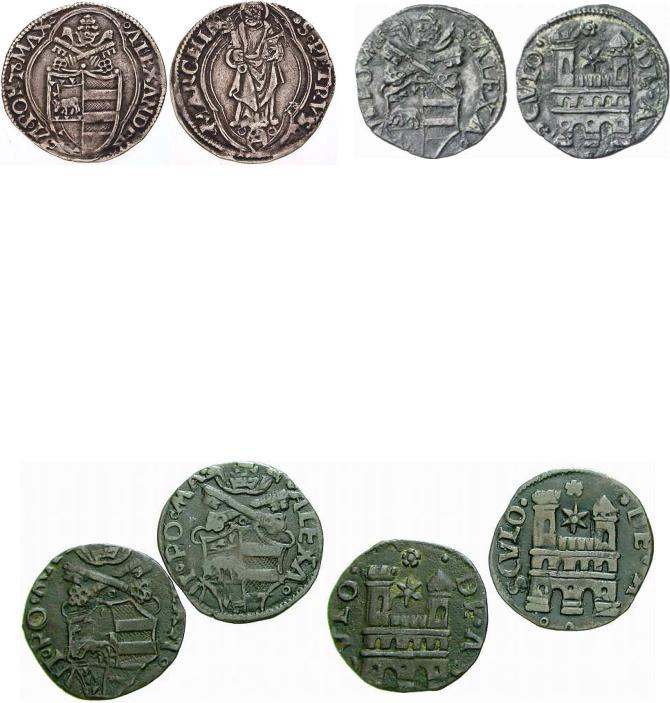
PAPAL COINS
Alexander VI., 1492-1503.
1/3 Grosso. Ancona mint. 0,97 g.
Obv.: Coat of arms surmounted by crossed keys and papal tiara, in quadrilobe.
.ALEXANDER. .VI.PONT..MAX.
Rev.: Nimbate St. Peter frontal, with key and book, standing over mintmark. S. PETRVS MARCHIA
Reference: Berman 539; CNI 18; Muntoni 24. VF.
Estimation DM 250. Price realized: 725 DEM (approx. 329 U.S. Dollars as of the auction date)
PAPAL COINS
Alexander VI., 1492-1503.
Doppio quattrino. Ascoli mint.
Obv.: Coat of arms surmounted by crossed keys and papal tiara. ALEXA VI PO MA
Rev.: 2-towered church with star above. Rosette at top. DE ASCVLO
Rare, green patina. VF-XF.
Estimate: 75 EUR. Price realized: 180 EUR (approx. 276 U.S. Dollars as of the auction date)
PAPAL COINS
Alexander VI., 1492-1503.
Cu-Quattrino. Ascoli mint. 2 Coins*
Obv.: Coat of arms surmounted by crossed keys and papal tiara. ALEXA VI PO MA
Rev.: 2-towered church with star above. Rosette at top. DE ASCVLO
Reference:. Berman 543; CNI 1; Muntoni 28. VF.
Estimation DM 75. Price realized: 250 DEM (approx. 114 U.S. Dollars as of the auction date)
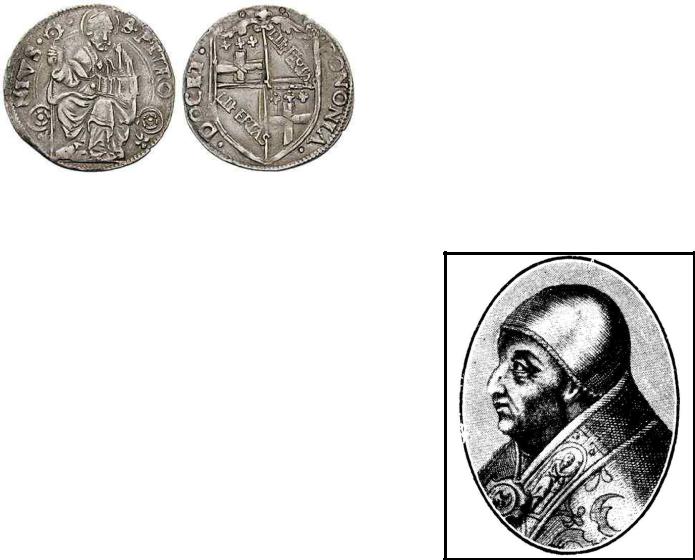
ANONYMOUS ISSUE - 16th CENTURY
PAPAL COINS
Anonymous Papal issues. 16th Century.
AR Carlino. Bologna mint. 1.90 g.
Obv.: Civic arms DOCET PONONIA
Rev.: St. Petronius with crozier and city model. S PETRONIVS
Reference: Muntoni IV pg. 164, 30; CNI X pg. 80, 25; Berman 762. VF, lightly toned.
Estimate $100. Price realized: 90 USD.
Pius III - 22 Sept. 1503 to 18 Oct.1503
Pope Pius III (May 29, 1439 – October 18, 1503), born Francesco Todeschini Piccolomini, was Pope from September 22 to October 18, 1503.
He was born in Siena, the nephew of Aeneas Silvius Piccolomini, the future Pope Pius II, by his sister Laodamia. He was received as a boy into the household of Aeneas Silvius, who permitted him to assume the name and arms of the Piccolomini family (his brother Antonio being made Duke of Amalfi during the pontificate of Pius II). Pius II appointed him in 1460, when only 22 years of age, to the see of Siena, which he had just raised to an archbishopric and made him a cardinal, at his first consistory, 5 March 1460. Within months he sent him as legate to the March of Ancona, with the experienced bishop of Marsico as his counsellor. He proved studious and effective.
Cardinal Piccolomini participated in the conclave that elected Pope Paul II (1464–71) in 1464 but was absent when Pope Sixtus IV (1471–84) was elected in 1471. He was employed in several important legations, as by Paul II at the Imperial diet at Regensburg/Ratisbon, and by Sixtus IV to secure the restoration of ecclesiastical authority in Umbria. He participated
in the conclave of 1484 which elected Innocent VIII and in the conclave of 1492 which elected Alexander VI. The cardinal was involved in Alexander's brief-lived effort to reform the Roman curia, following the murder of his son Giovanni Borgia (1474) in 1497.
In 1502 the Cardinal commissioned a library with access from an aisle of the Duomo di Siena, which was intended to house the library of humanist texts assembled by his uncle, and commissioned the artist Pinturicchio to fresco its vault and ten narrative panels along the walls depicting scenes from the life of Aeneas Silvius Piccolomini. Though Pinturrichio labored for five years, in the event, the books never reached their splendid destination; yet the Piccolomini Library is a monument of the High Renaissance in Siena. It gives an edited version of Pius' life, passing over his former support of the antipope Felix V.
Amid the disturbances consequent upon the death of the Borgia Pope Alexander VI (1492–1503), it took the combined pressures of all the ambassadors to induce Cesare Borgia to withdraw from Rome, so that an unpressured conclave might take place. In it, Cardinal Piccolomini was elected Pope Pius III on September 22, 1503. This selection can be seen as a compromise between factions, Borgia and della Rovere, picking a frail cardinal with long experience in the Curia over the kin of either Sixtus IV or Alexander VI. His coronation took place on October 8, 1503. He at once took in hand the reform of the papal court and arrested Cesare Borgia; but after a brief pontificate of twenty-six days he died (October 18, 1503) of an ulcer in the leg, or, as some have alleged, of poison administered at the instigation of Pandolfo Petrucci, governor of Siena.
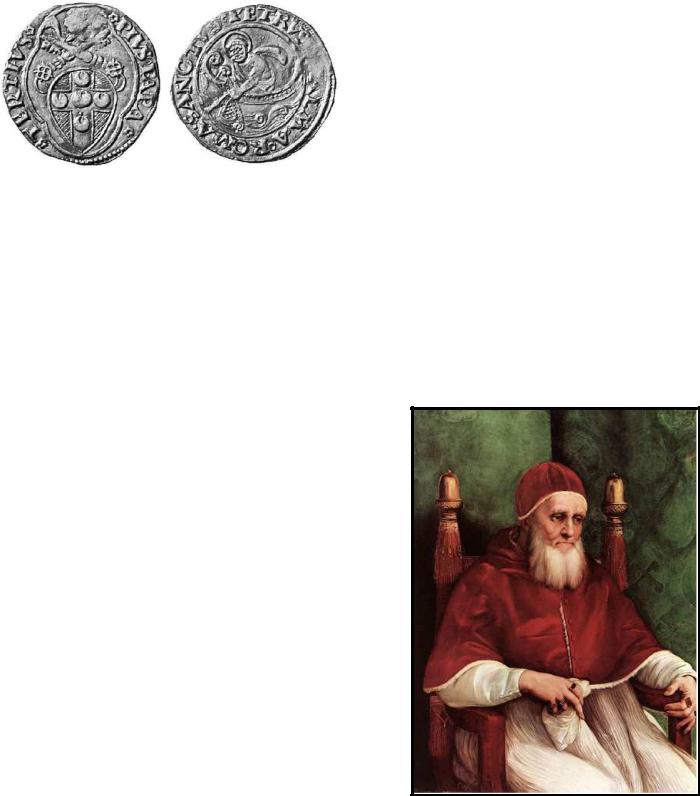
PAPAL COINS
Piis III, 22 Sept.-17 Oct. 1503.
AV Fiorino di camera. Rome mint. 22 mm 3,36 g.
Obv.: PIVS PAPA TERTIVS Coat of arms surmounted by crossed keys and papal tiara.
Rev.: ·SANCTVS PETRVS· ·ALMAROMA Nimate St. Peter facing to left, fishing with net from boat.
Reference: CNI 1 var. M 1 var. B 551. Extremeley rare. VF.
Estimate CHF 20000. Price realized: 21,500 CHF (approx. 15,892 U.S. Dollars as of the auction date)
Julius II - 31 Oct. 1503 to 21 Feb. 1513
Pope Julius II (December 5, 1443 – February 21, 1513), born Giuliano della Rovere, was Pope from 1503 to 1513. His reign was marked by an aggressive foreign policy, ambitious building projects, and patronage for the arts.
There is disagreement about Julius' date of birth. Some sources put his birth as late as 1453.
Giuliano della Rovere was an altar boy of Pope Sixtus IV Francesco della Rovere (1471–84). He was educated among the Franciscans by his uncle, who took him under his special charge and later sent him to a convent in La Pérouse with the purpose of obtaining knowledge of the sciences. However, he does not appear to have joined the order of St. Francis, but rather remained a member of the secular clergy until his elevation to bishop of Carpentras, France, in 1471; very shortly after his uncle succeeded to the papal chair.
He was promoted to cardinal, taking the same title formerly held by his uncle, Cardinal of San Pietro in Vincula. With his uncle as Pope, he obtained great influence, and he held no fewer than eight bishoprics (e.g. Lausanne 1472–1476; Coutances 1476–1478), in addition to the archbishopric of Avignon.
In the capacity of papal legate he was sent to France in 1480, where he remained four years, and acquitted himself with such ability that he soon acquired a paramount influence in the College of Cardinals, an influence which increased rather than diminished during the pontificate of Pope Innocent VIII.
However, a rivalry had gradually grown up between him and Cardinal Rodrigo Borgia, and on the death of Innocent VIII in 1492 Borgia was elected Pope Alexander VI (1492–1503). Della Rovere, jealous and angry, accused Borgia of being elected over him by means of simony and a secret agreement with Ascanio Sforza. Della Rovere at once determined to take refuge from Borgia's wrath at Ostia, and in a few months afterwards went to Paris, where he incited Charles VIII of France (1483–98) to undertake the conquest of Naples. Accompanying the young King on his campaign, he entered Rome along with him, and endeavoured to instigate the convocation of a council to inquire into the conduct of the Pope with a view to his deposition; but Alexander VI, having gained a friend in Charles VIII's minister Briçonnet by offering him the position of cardinal, succeeded in defeating the machinations of his enemy.
Alexander VI died in 1503, most likely due to malaria, though his death is often attributed to poison. Alexander VI's son, Cesare also fell ill at the same time. Della Rovere did not support the candidature of Cardinal Piccolomini of Siena, who was (on October 8, 1503) consecrated under the name of Pope Pius III by Della Rovere, but who died 10 days afterwards. Della Rovere then succeeded by dexterous diplomacy in tricking the weakened Cesare Borgia into supporting him. He was elected as Pope Julius II to the papal dignity by the near-unanimous vote of the cardinals (indeed, the only 3 votes he did not receive were those of Georges D'Amboise, supposedly his main opponent and the favourite of the French monarchy, and the votes of Cardinals Carafa and Casanova) almost certainly by means of bribery. His election only took a few hours.
Giuliano took the name of his fourth century predecessor, Julius I (337–352). From the beginning, Julius II set himself with a courage and determination rarely equalled, to rid himself of the various powers under which his temporal authority was almost overwhelmed. By a series of complicated stratagems he first succeeded in rendering it impossible for the Borgia to retain their power over the Papal States. He then used his influence to reconcile the two powerful Roman families of Orsini and Colonna, and, by decrees made in their interest, he also attached to himself the remainder of the Roman nobility.
Being thus secure in Rome and the surrounding country, he next set himself to oust the Republic of Venice from Faenza, Rimini, and the other towns and fortresses of Italy which it occupied after the death of Pope Alexander VI. In 1504, finding it impossible to succeed with the Doge of Venice by remonstrance, he brought about a union of the conflicting interests of France and the Holy Roman Empire (Germany), and sacrificed temporarily to some extent the independence of Italy in order to conclude with them an offensive and defensive alliance against Venice. The combination was, however, at first little more than nominal, and was not immediately effective in compelling the Venetians to deliver up more than a few unimportant places in the Romagna. But, by a brilliant campaign in 1506, Julius II succeeded in freeing Perugia and Bologna from their despots (Giampolo Baglioni and Giovanni II Bentivoglio, respectively), and raised himself to such a height of influence as to render his friendship of prime importance both to the King of France and the Holy Roman Emperor.
1506 (namely January 21) was also the official founding date of the Swiss Guard, in order to provide a constant corps of soldiers to protect the Pope. Given these political struggles during Julius's papacy, it is no surprise that he was their founder.
In 1508, events so favoured the plans of Julius II that he was able to conclude the League of Cambrai with Louis XII, King of France (1498–1515), Maximilian I, Holy Roman Emperor (1493–1519), and Ferdinand II, King of Aragon (1479–1516). The League fought against the Republic of Venice during the "War of the Holy League," also known as the "War of the League of Cambrai." Among other things, Julius II wanted the Venetian possession of Romagna; Emperor Maximilian I wanted Friuli and Veneto; Louis XII wanted Cremona; and Ferdinand II wanted the Apulian ports.This war was a conflict in what was collectively known as the "Italian Wars" (1494–1559). In the spring of 1509, the Republic of Venice was placed under an interdict by Julius II. During the course of the "War of the Holy League" and the "Italian Wars" in general, alliances and participants changed dramatically. For example, in 1510 Venice and France switched places. By 1513, Venice had joined France.
The achievements of the League soon outstripped the primary intention of Julius II. By one single battle, the Battle of Agnadello (14 May 1509), the dominion of Venice in Italy was practically lost. But, as neither the King of France nor the Holy Roman Emperor were satisfied with merely effecting the purposes of the Pope, the latter found it necessary to enter into an arrangement with the Venetians to defend himself from those who immediately before had been his allies against them. The Venetians on making humble submission were absolved in the beginning of 1510, and shortly afterwards France was placed under the papal ban. Attempts to bring about a rupture between France and England proved unsuccessful. On the other hand, at a synod convened by Louis XII at Tours in September 1510 the French bishops withdrew from the papal obedience, and resolved, with Maximilian I's cooperation, to seek the deposition of Julius II. In November 1511, a council actually met for this object at Pisa.
Julius II thereupon entered into the "Holy League of 1511." He was now allied with Ferdinand II and the Venetians against France. In short time, both Henry VIII, King of England (1509–47), and Maximilian I also joined the "Holy League of 1511."
Julius II also convened a general council (that afterwards was known as the Fifth Council of the Lateran) to be held at Rome in 1512, which, according to an oath taken on his election, he had bound himself to summon, but which had been delayed, he affirmed, on account of the occupation of Italy by his enemies.
In 1512 the French were driven across the Alps, but it was at the cost of the occupation of Italy by the other powers, and Julius II, though he had securely established the papal authority in the states immediately around Rome, was practically as far as ever from realizing his dream of an independent Italian kingdom when he died of fever in February 1513.
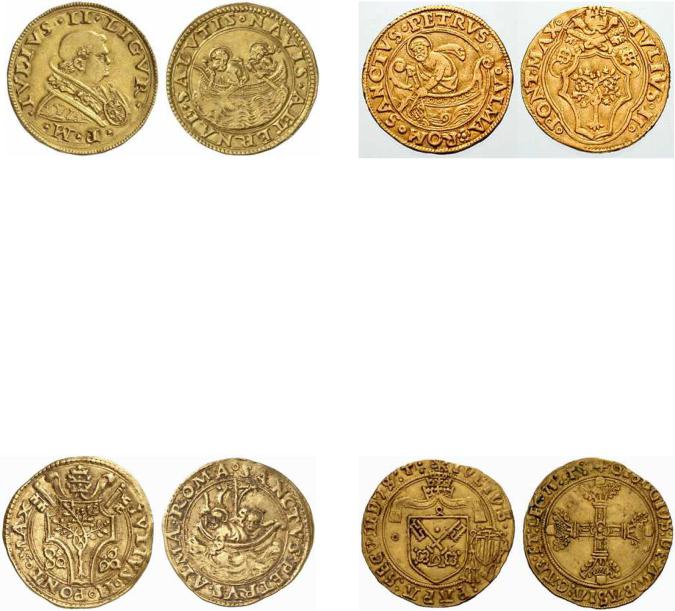
PAPAL COINS
Julius II. 1503-1513.
Doppio fiorino di camera. Rome mint. 7,05 g.
Obv.: IVLIVS. II. LIGVR. P. M. Capped bust of pope to right.
Rev.: NAVIS. AETERNAE. SALVTIS St. Peter and St. Andrew fishing from boat
Reference: Berman 556; CNI 3; Muntoni 4; Friedberg 36. Rare. XF.
Estimation CHF 8000. Price realized: 14,500 CHF (approx. 11,007 U.S. Dollars as of the auction date)
PAPAL COINS
Julius II. 1503-1513.
Fiorino di camera. Rome mint.
Obv.: IVLIVS II PONT MAX, arms in double quadrilobe surmounted by crossed keys and papal tiara. Trilobe marks either side orf arms.
Rev.: SANCTVS PETRVS ALMA ROMA Nimbate St. Peter facing to left, fishing in boat with net, nimbate St. Andrew on right in boat.
Reference: Friedb. 40, Munt. 15 var. VF.
Starting Price EUR 500. Price realized: 650 EUR (approx. 951 U.S. Dollars as of the auction date)
PAPAL COINS
Julius II. 1503-1513.
Fiorino di camera. Rome mint. 3.35 g.
Obv.: IVLIVS II PONT MAX, arms in double quadrilobe surmounted by crossed keys and papal tiara.
Rev.: SANCTVS PETRVS ALMA * RO(MA) in monogram, nimbate St. Peter facing to left, fishing in boat with net.
Reference: Muntoni I pg. 101, 15 var.; Serafini pg. 160, 4 var.; CNI XV pg. 323, 39; Berman 561. VF. Scarce variety.
Estimate $600. Price realized: 750 USD.
PAPAL COINS
Julius II. 1503-1513.
Ecu d’or. Avignon mint. 3.43 g.
Obv.: IVLIVS PAPA SECVNDVS :T: Shield with crossed keys topped by papal tiara over ribbon. Arms of Legate Georges d’Ambien at right.
Rev.: Florate cross in circle. GEORGIVS LE AMBASIA CAR ET LEG A T
Reference: Fr:41 (France), Munt:78. VF.
Estimate: EUR 3000. Price realized: 3,000 EUR (approx. 3,854 U.S. Dollars as of the auction date)

PAPAL COINS
Julius II. 1503-1513.
Ducato. Bologna mint. 3,41 g.
Obv.: IVLIVS II PONT MAX Arms over crossed keys, surmounted by papal tiara; all in double quadrilobe.
Rev.: DOCET BONONI Nimbate St. Peter stands frontal with key and book., flanked by family and Bologna coats of arms at bottom.
Reference: Fr:332a. VF.
PAPAL COINS
Julius II. 1503-1513.
Ducato. Bologna mint. 3,43 g.
Obv.: IVLIVS II PONT MAX Arms over crossed keys, surmounted by papal tiara; all in double quadrilobe.
Rev.: DOCET BONONI Nimbate St. Peter stands frontal with key and book., flanked by family and Bologna coats of arms at bottom.
Reference: Fb. 332; Muntoni 84. GOLD. Rare. VF.
Estimate: EUR 500. Price realized: 800 EUR (approx. 1,074 U.S. Dollars as of the auction date)
PAPAL COINS
Julius II. 1503-1513.
Ducato. Bologna mint. 3,43 g.
Obv.: IVLIVS II PONT MAX Arms over crossed keys, surmounted by papal tiara; all in double quadrilobe.
Rev.: DOCET BONONI Nimbate St. Peter stands frontal with key and book., flanked by family and Bologna coats of arms at bottom.
Reference: Fb. 332; Muntoni 84. GOLD. Attractive, VF example.
Estimate: 800 EUR. Price realized: 1,600 EUR (approx. 2,452 U.S. Dollars as of the auction date)
Estimate: 1.500 EUR. Price realized: 1,200 EUR (approx. 1,523 U.S. Dollars as of the auction date)
PAPAL COINS
Julius II. 1503-1513.
Ducato. Bologna mint. 3,46 g.
Obv.: IVLIVS PAPA II Arms over crossed keys, surmounted by papal tiara; all in double quadrilobe.
Rev.: DOCET BONONIA Nimbate St. Peter stands frontal with key and book., flanked by coats of arms at bottom. (Bologna and shield with letters LIHTA.
Reference: Fb. 332; Muntoni 85. GOLD. Rare. VF.
Estimate: 800 EUR. Price realized: 1,100 EUR (approx. 1,686 U.S. Dollars as of the auction date)
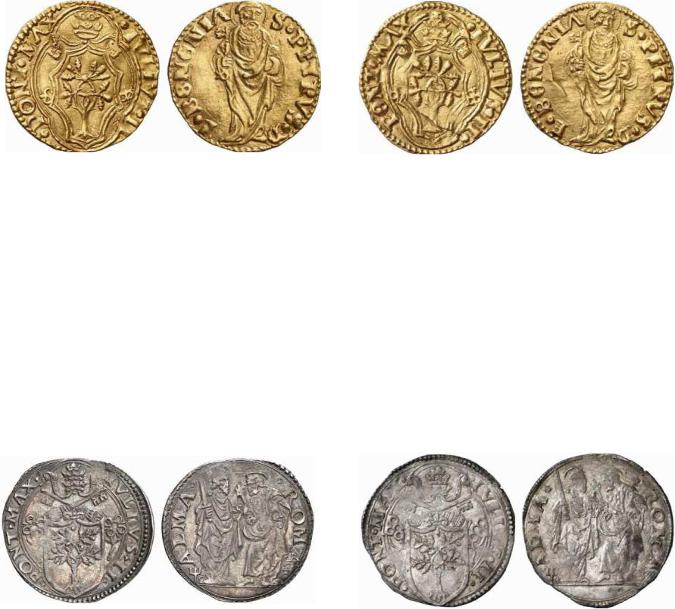
PAPAL COINS
Julius II. 1503-1513.
Ducato. Bologna mint. 3,43 g.
Obv.: IVLIVS II PONT MAX Arms over crossed keys, surmounted by papal tiara; all in double quadrilobe.
Rev.: S PETRVS DE BONONIA Nimbate St. Peter stands frontal with key and book.
Reference: Fb. 332 a (incorrect picture in the book); Muntoni 89 var. GOLD. Rare, VF.
Estimate: 800 EUR. Price realized: 850 EUR (approx. 1,303 U.S. Dollars as of the auction date)
PAPAL COINS
Julius II. 1503-1513.
Giulio. Rome mint.
Obv.: Coat of arms surmounted by crossed keys and papal tiara. IVLIVS II PONT MAX
Rev.: Nimbate St.. Paul with sword and book, and nimbate St. Peter with key and book, side by side, both looking to center. ALMA ROMA Fugger Trident mark field left.
Reference: Munt. 20. VF.
Starting Price EUR 75. Price realized: 160 EUR (approx. 234 U.S. Dollars as of the auction date)
PAPAL COINS
Julius II. 1503-1513.
Ducato. Bologna mint. 3,45 g.
Obv.: IVLIVS II PONT MAX Arms over crossed keys, surmounted by papal tiara; all in double quadrilobe.
Rev.: S PETRVS DE BONONIA Nimbate St. Peter stands frontal with key and book.
Reference: Fb. 332 a (incorrect picture in the book); Muntoni 89 var. GOLD. Rare, minor rim damage, VF.
Estimate: 750 EUR. Price realized: 800 EUR (approx. 1,226 U.S. Dollars as of the auction date)
PAPAL COINS
Julius II. 1503-1513.
Giulio. Rome mint. 29 mm 3,88 g.
Obv.: Coat of arms surmounted by crossed keys and papal tiara. IVLIVS II PONT MAX
Rev.: Nimbate St.. Paul with sword and book, and nimbate St. Peter with key and book, side by side, both looking to center. ALMA ROMA Fugger Trident mark field left.
Reference: Muntoni 20, CNI 58, Berman 566. Selten. Sehr schön.
Estimate: EUR 250.
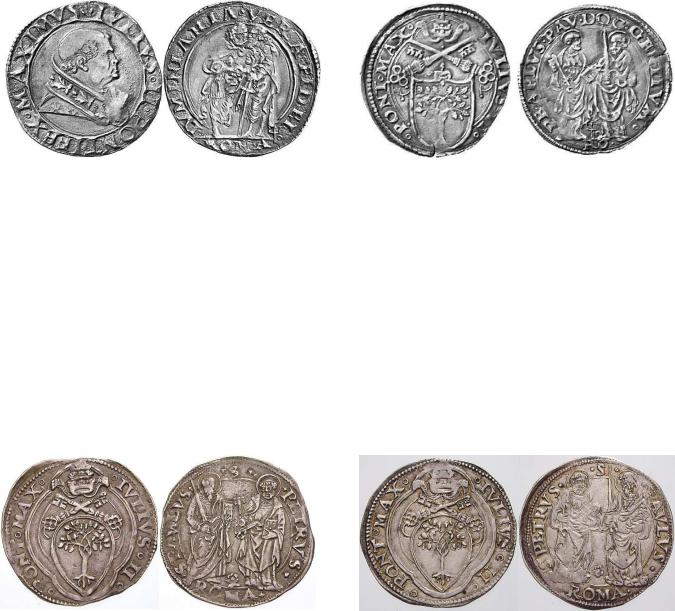
PAPAL COINS
Julius II. 1503-1513.
Giulio. Rome mint. 29 mm 3,44 g.
Obv.: IVLIVS II PONTIFEX MAXIMVS Capped bust of Pope Julius II to right.
Rev. Sts. Peter and Paul embracing each other; below right, Fugger symbol. LVMINIARIA VERA FIDEI
Reference: Berman 570. CNI XV, p. 324, 48. Muntoni 24. Attractively toned. Fields lightly smoothed and with traces of corrosion, otherwise, good very fine.
Estimate: CHF 750.00. Price realized: 1,200 CHF (approx. 798 U.S. Dollars as of the auction date)
PAPAL COINS
Julius II. 1503-1513.
Giulio. Rome mint. 3,78 g.
Obv.: Coat of arms surmounted by crossed keys and papal tiara, in quadrilobe. IVLIVS II PONT MAX
Rev.: Nimbate St. Paul with sword and book and St. Paul with key and book stand frontal, looking to each other at center. Rosette between their feet. S PAVLVS S PETRVS ROMA in exurge.
Reference: Berman 574; CNI 103; Muntoni 30. VF.
Estimation DM 250. Price realized: 450 DEM (approx. 204 U.S. Dollars as of the auction date)
PAPAL COINS
Julius II. 1503-1513.
Giulio. Rome mint.
Obv.: Coat of arms surmounted by crossed keys and papal tiara. IVLIVS II PONT MAX
Rev.: PE APLVS PAV DOC GENTIVM RO below in field. Nimbate St. Peter with key and book and nimbate St. Paul with sword and book frontal, looking to each other at center.
Muntoni 27. R Winz. Schrötlingsfehler am Rand, sehr schön +
Schätzpreis: 400,00 EUR. Price realized: 360 EUR (approx. 413 U.S. Dollars as of the auction date)
PAPAL COINS
Julius II. 1503-1513.
Giulio. Rome mint. 3,78 g.
Obv.: Coat of arms surmounted by crossed keys and papal tiara, in quadrilobe. IVLIVS II PONT MAX
Rev.: Nimbate St. Peter with key and book and nimbate St. Paul with sword and book frontal, looking to each other at center. Rosette between them at feet. S PETRVS S PAVLVS ROMA in exurge.
Reference: Berman 576; CNI 102; Muntoni 32. VF.
Estimation DM 250. Price realized: 450 DEM (approx. 204 U.S. Dollars as of the auction date)
